Material Optimization Method for a Spring-Energized Seal Based on Wear Analysis
Abstract
:1. Introduction
2. Performance Prediction Model for Spring-Energized Seals
2.1. Structure and Working Principle of Face Rotary Spring-Energized Seals
2.2. Modified Archard Wear Model for Spring-Energized Seals
2.3. Preparation of PTFE Composites with Wear-Resistant Fillers
3. Results and Discussion
3.1. Performance Testing of PTFE Composites with Wear-Resistant Fillers
3.2. Simulation Analysis
3.3. Experimental Verification
4. Conclusions
- (1)
- The addition of 5 wt.% filler had a negligible influence on the mechanical properties of the PTFEs but significantly impacted their tribological performance. The friction coefficient of the jacket material had little effect on the stress distribution of the whole jacket and primarily affected the friction torque of the spring-energized seal. With an increase in the wear rate, the contact stress on the sealing surface decreased, the contact width increased, and the friction torque decreased faster. The wear rates of the jacket material were 26.56 times larger, and the friction torque reduction rates were 95.09% and 24.12%, a 3.94-fold difference.
- (2)
- The wear simulation model based on the Archard wear model can accurately simulate the sealing performance of spring-energized seals with different filled PTFE jackets after wear. After a certain amount of wear, the deviation between the simulation data and the test data was within ±5%.
- (3)
- When the performance prediction model was used to improve the jacket material of the spring-energized seal, it was found that, compared to the spring-energized seal made of pure PTFE, the friction torque of the spring-energized seal made of GF/PTFE was reduced by a maximum of 28.97%, and the friction torque reduction rate decreased by 22.25%.
Author Contributions
Funding
Data Availability Statement
Acknowledgments
Conflicts of Interest
Correction Statement
References
- Amenta, F.; Bolelli, G.; De Lorenzis, S.; Bertarini, A.; Lusvarghi, L. Tribological Behavior of Reinforced PTFE Composites and Un-Reinforced Polyketone-Based Materials against Coated Steel. Lubricants 2021, 10, 5. [Google Scholar] [CrossRef]
- Ma, K.; Guan, K.; Cai, R. Compression recovery performance of spring energized C-rings. Proc. Inst. Mech. Eng. Part E J. Process Mech. Eng. 2014, 230, 18–25. [Google Scholar] [CrossRef]
- Peng, S.; Guo, Y.; Xie, G.; Luo, J. Tribological behavior of polytetrafluoroethylene coating reinforced with black phosphorus nanoparticles. Appl. Surf. Sci. 2018, 441, 670–677. [Google Scholar] [CrossRef]
- Zhao, Y.; Qi, X.; Ma, J.; Dong, Y.; Yang, Y. Effects of polyimide/silica and polyimide/pores fillers on the morphology, thermal, mechanical, and tribological properties of polytetrafluoroethylene composites. Polym. Compos. 2019, 40, 3438–3452. [Google Scholar] [CrossRef]
- Vasilev, A.P.; Struchkova, T.S.; Alekseev, A.G. Development of Antifriction Materials Based on Polytetrafluoroethylene with Carbon Fibers and Tungsten Disulfide. Mater. Sci. Forum 2020, 992, 745–750. [Google Scholar] [CrossRef]
- Fan, M.; He, W.; Li, Q.; Zhou, J.; Shen, J.; Chen, W.; Yu, Y. PTFE Crystal Growth in Composites: A Phase-Field Model Simulation Study. Materials 2022, 15, 6286. [Google Scholar] [CrossRef]
- Bhargava, S.; Blanchet, T.A. Unusually Effective Nanofiller a Contradiction of Microfiller-Specific Mechanisms of PTFE Composite Wear Resistance? J. Tribol. 2016, 138, 042001. [Google Scholar] [CrossRef]
- Bhargava, S.; Makowiec, M.E.; Blanchet, T.A. Wear reduction mechanisms within highly wear-resistant graphene- and other carbon-filled PTFE nanocomposites. Wear 2020, 444–445, 203163. [Google Scholar] [CrossRef]
- Fan, X.; Li, G.; Guo, Y.; Zhang, L.; Xu, Y.; Zhao, F.; Zhang, G. Role of reinforcement types and silica nanoparticles on tribofilm growth at PTFE-Steel interface. Tribol. Int. 2020, 143, 106035. [Google Scholar] [CrossRef]
- Qiu, X.; Fu, C.; Gu, A.; Gao, Y.; Wang, X.; Yu, Z. Preparation of high-performance PEEK anti-wear blends with melt-processable PTFE. High Perform. Polym. 2019, 32, 645–654. [Google Scholar] [CrossRef]
- Fang, K. Frictional Performance of Polyphenyl Ester Modified Polytetrafluoroethylene. Mater. Sci. Forum 2023, 1080, 33–39. [Google Scholar] [CrossRef]
- Ma, G.; Ding, G.; Liu, X.; Wang, H.; Zhai, H.; Zhu, H. Change in Surface Microstructure and Properties of PTFE after Solar Radiation and its Mechanism. J. Wuhan Univ. Technol.-Mater. Sci. Ed. 2019, 34, 223–229. [Google Scholar] [CrossRef]
- Chen, S.; Guo, F.; Wang, W.; Wang, Y. An improved mixed lubrication model for revealing the mechanism of high speed and frictional heat on sealing performance. Tribol. Int. 2024, 191, 109147. [Google Scholar] [CrossRef]
- Huang, T.-C.; Lin, C.-Y.; Liao, K.-C. Experimental and numerical investigations of the wear behavior and sealing performance of PTFE rotary lip seals based on the elasto-hydrodynamic analysis with considerations of the asperity contact. Tribol. Int. 2023, 187, 108747. [Google Scholar] [CrossRef]
- Huang, T.C.; Lin, C.Y.; Liao, K.C. Sealing performance assessments of PTFE rotary lip seals based on the elasto-hydrodynamic analysis with the modified archard wear model. Tribol. Int. 2022, 176, 107917. [Google Scholar] [CrossRef]
- Huang, T.C.; Tsai, J.W.; Liao, K.C. Wear and leakage assessments of canted coil Spring–Energized polytetrafluoroethylene seals under Ultra-High cycle operations. Eng. Fail. Anal. 2022, 135, 106–110. [Google Scholar] [CrossRef]
- Amenta, F.; Bolelli, G.; Pedrazzi, S.; Allesina, G.; Santeramo, F.; Bertarini, A.; Sassatelli, P.; Lusvarghi, L. Sliding wear behaviour of fibre-reinforced PTFE composites against coated and uncoated steel. Wear 2021, 486–487, 204097. [Google Scholar] [CrossRef]
- Song, F.; Wang, Q.; Wang, T. Effects of glass fiber and molybdenum disulfide on tribological behaviors and PV limit of chopped carbon fiber reinforced Polytetrafluoroethylene composites. Tribol. Int. 2016, 104, 392–401. [Google Scholar] [CrossRef]
- Makowiec, M.E.; Blanchet, T.A. Improved wear resistance of nanotube- and other carbon-filled PTFE composites. Wear 2017, 374–375, 77–85. [Google Scholar] [CrossRef]
- Liu, D.; Zhao, J.; Li, S.; Zhao, X.; Huang, L. Experimental Study on Tribological and Leakage Characteristics of a Rotating Spring-Energized Seal under High and Low Temperature. Machines 2023, 11, 221. [Google Scholar] [CrossRef]
- Wang, A.; Lin, B.; Zou, H.; Wei, C.; Meng, Y.; Sui, T.; Yan, S. Effect of micrometer sized ceramic particles on the tribological properties of Polytetrafluoroethylene based composites. Surf. Topogr. Metrol. Prop. 2020, 8, 035005. [Google Scholar] [CrossRef]
- Raparelli, T.; Mazza, L.; Trivella, A. Experimental analysis and preliminary model of non-conventional lip seals. Tribol. Int. 2023, 181, 108311. [Google Scholar] [CrossRef]
- Dhanumalayan, E.; Joshi, G.M. Performance properties and applications of polytetrafluoroethylene (PTFE)—A review. Adv. Compos. Hybrid Mater. 2018, 1, 247–268. [Google Scholar] [CrossRef]
- Vasilev, A.P.; Lazareva, N.N.; Struchkova, T.S.; Okhlopkova, A.A.; Danilova, S.N. Mechanical and Tribological Properties of Polytetrafluoroethylene Modified with Combined Fillers: Carbon Fibers, Zirconium Dioxide, Silicon Dioxide and Boron Nitride. Polymers 2023, 15, 313. [Google Scholar] [CrossRef] [PubMed]
- Khanna, Y.P. The melting temperature of polytetrafluoroethylene. J. Mater. Sci. Lett. 1988, 7, 817–818. [Google Scholar] [CrossRef]
- Vasilev, A.P.; Struchkova, T.S.; Okhlopkova, A.A. Effects of Complex Fillers on the Mechanical and Tribological Properties of Polytetrafluoroethylene Composites. Mater. Sci. Forum 2020, 992, 739–744. [Google Scholar] [CrossRef]
- Bhargava, S.; Koratkar, N.; Blanchet, T.A. Effect of Platelet Thickness on Wear of Graphene–Polytetrafluoroethylene (PTFE) Composites. Tribol. Lett. 2015, 59, 17. [Google Scholar] [CrossRef]
- GB/T 39714.2-2020; Plastics—Polytetrafluoroethylene (PTFE) Semi-Finished Products—Part 2: Preparation of Test Specimens and Determination of Properties. Standardization Administration of China (SAC): Beijing, China, 2020.
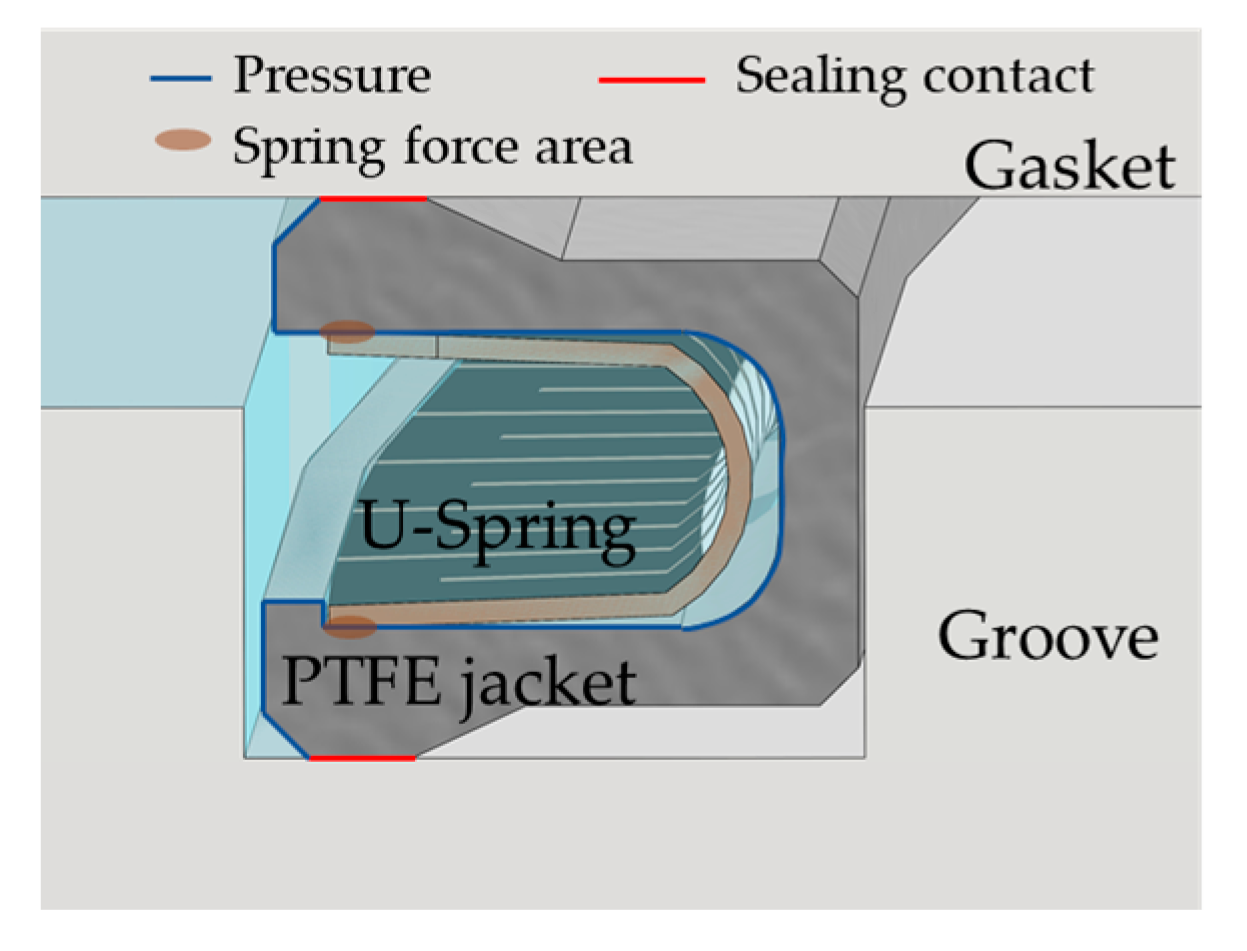
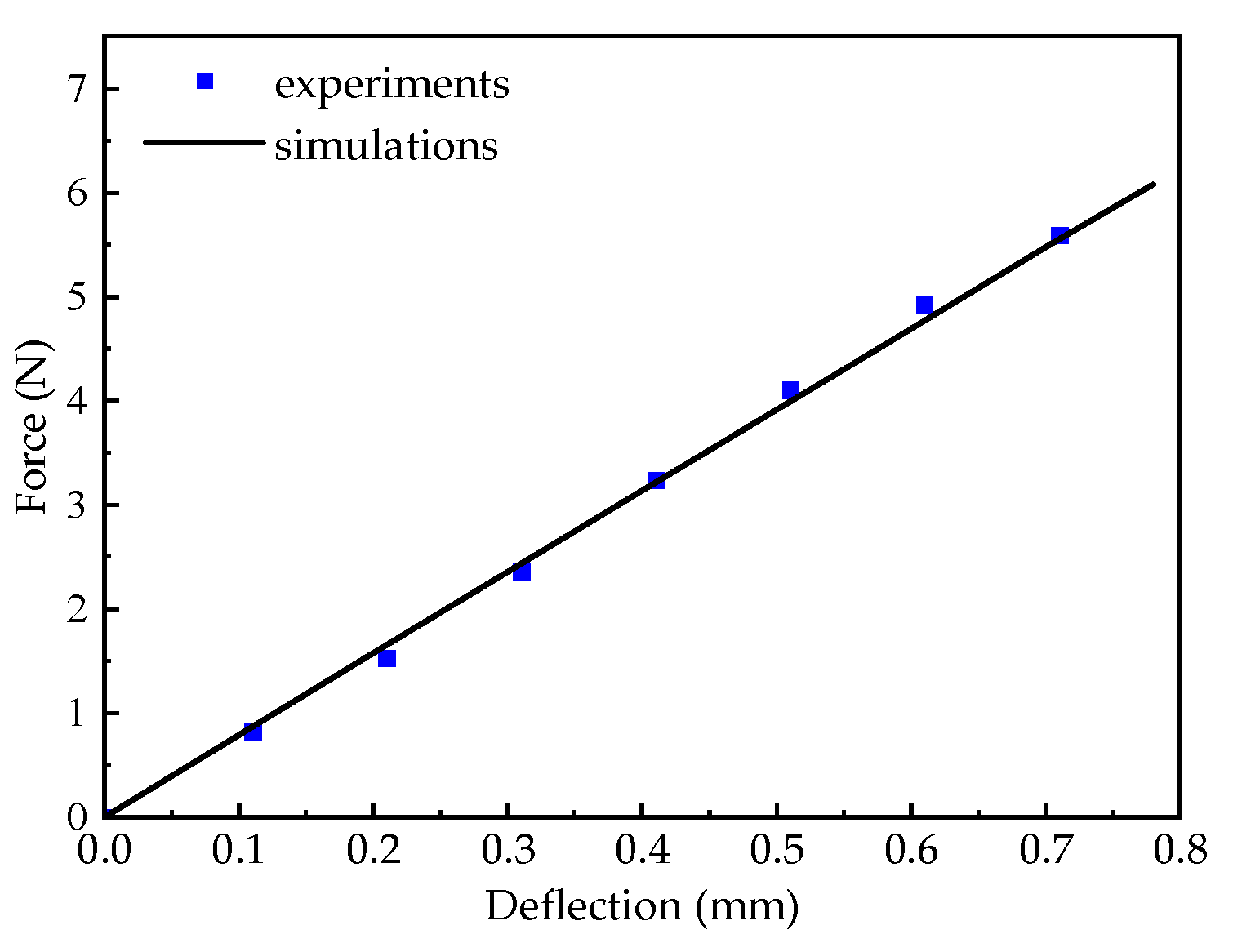


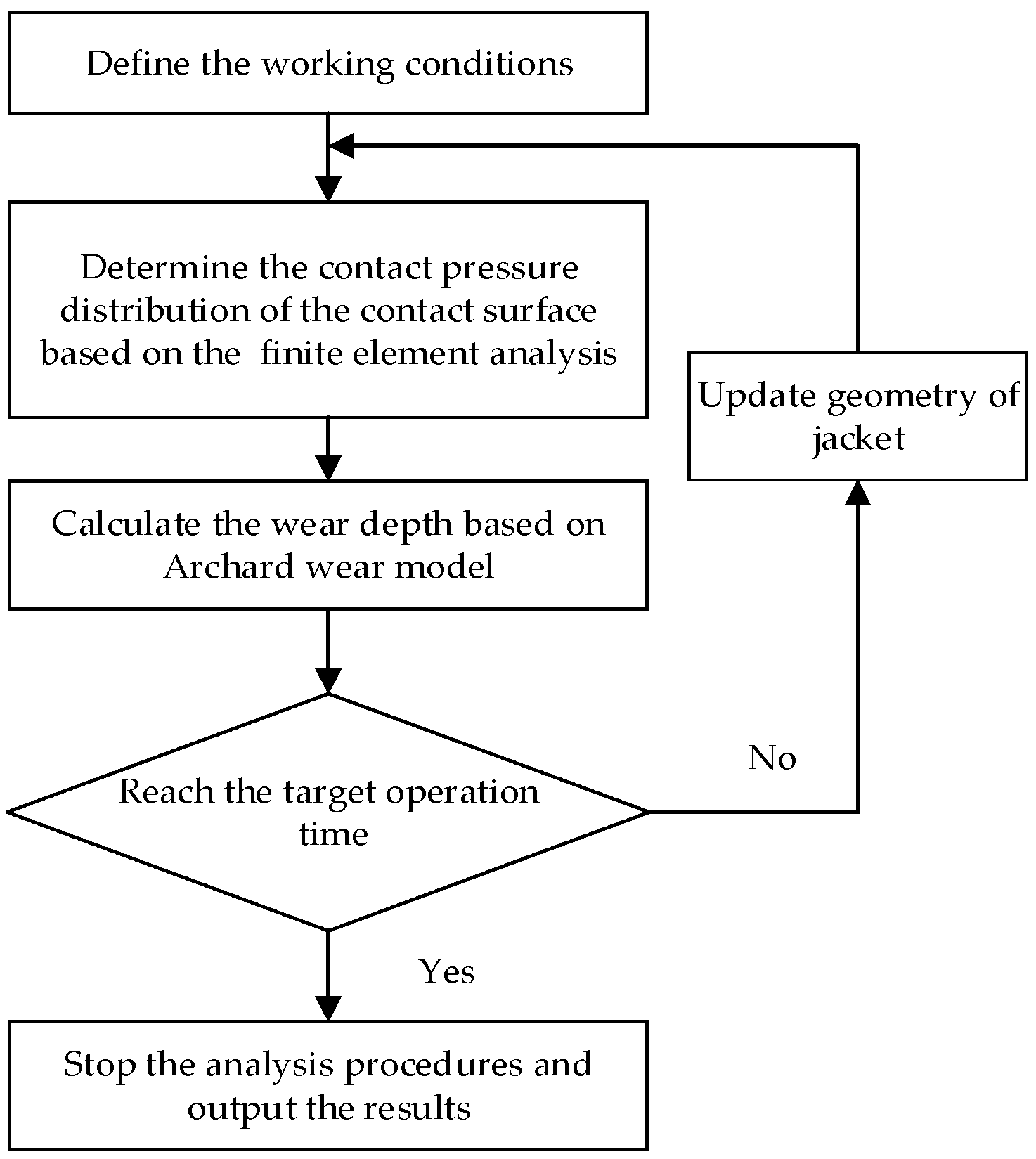
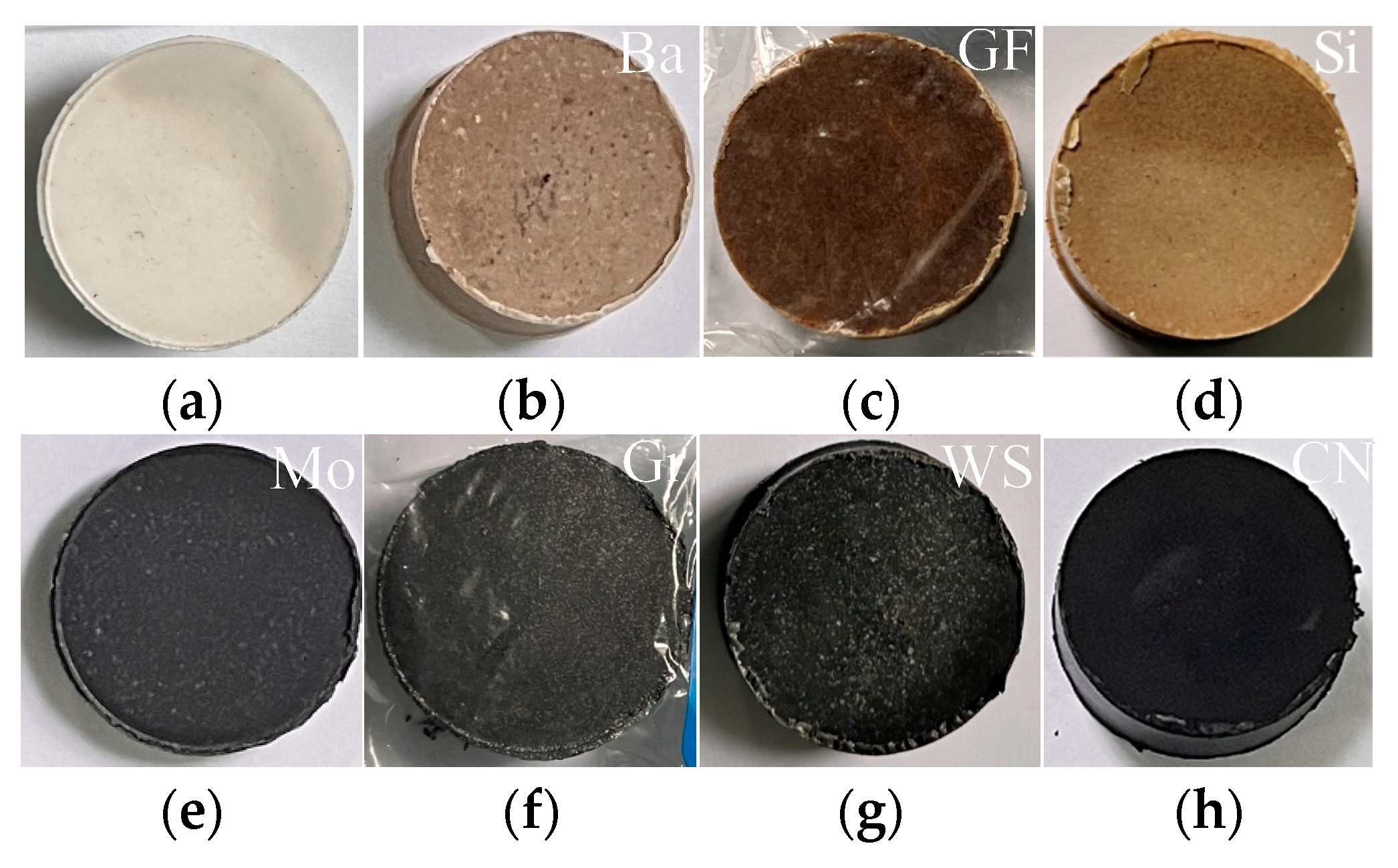

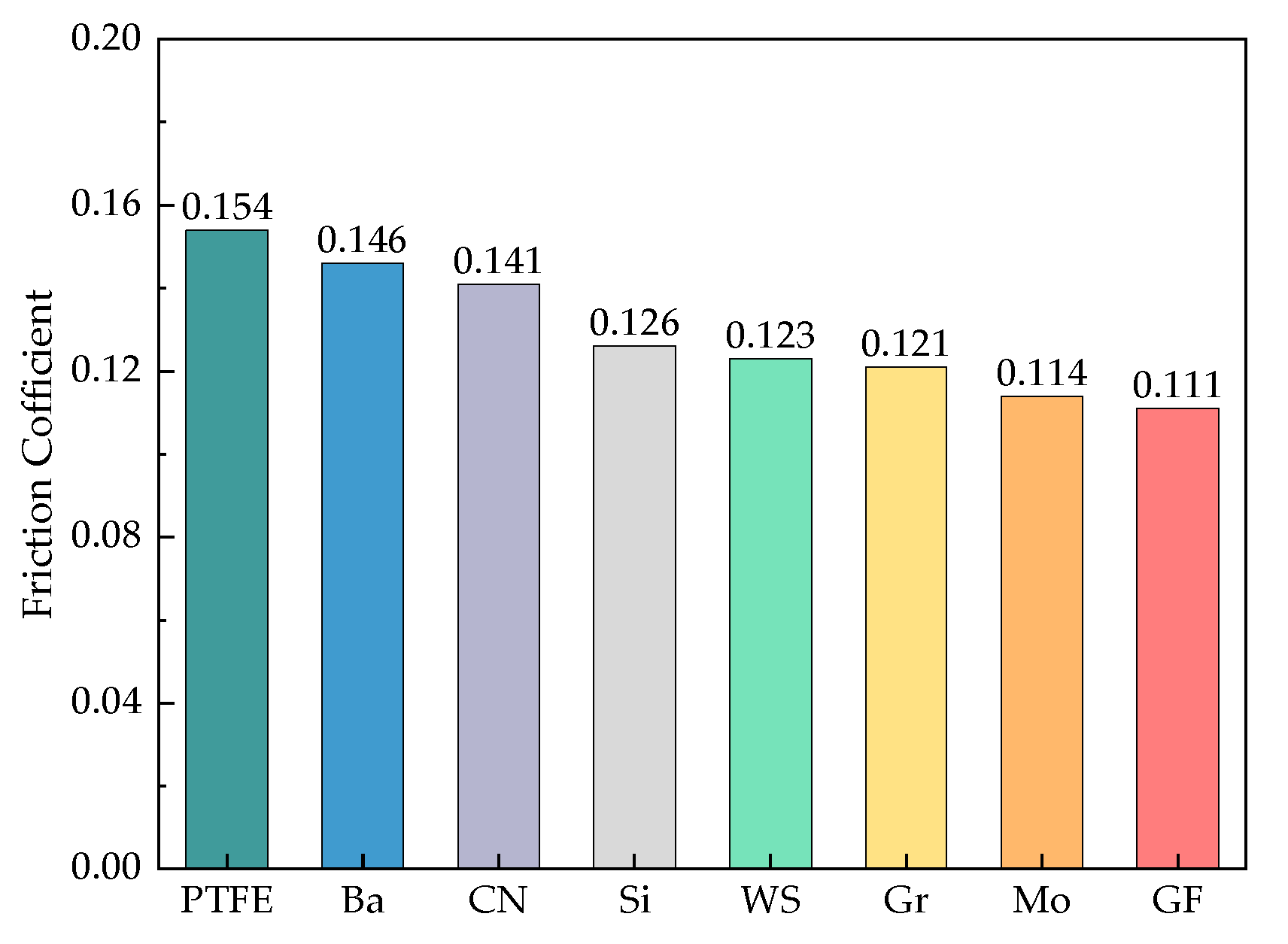
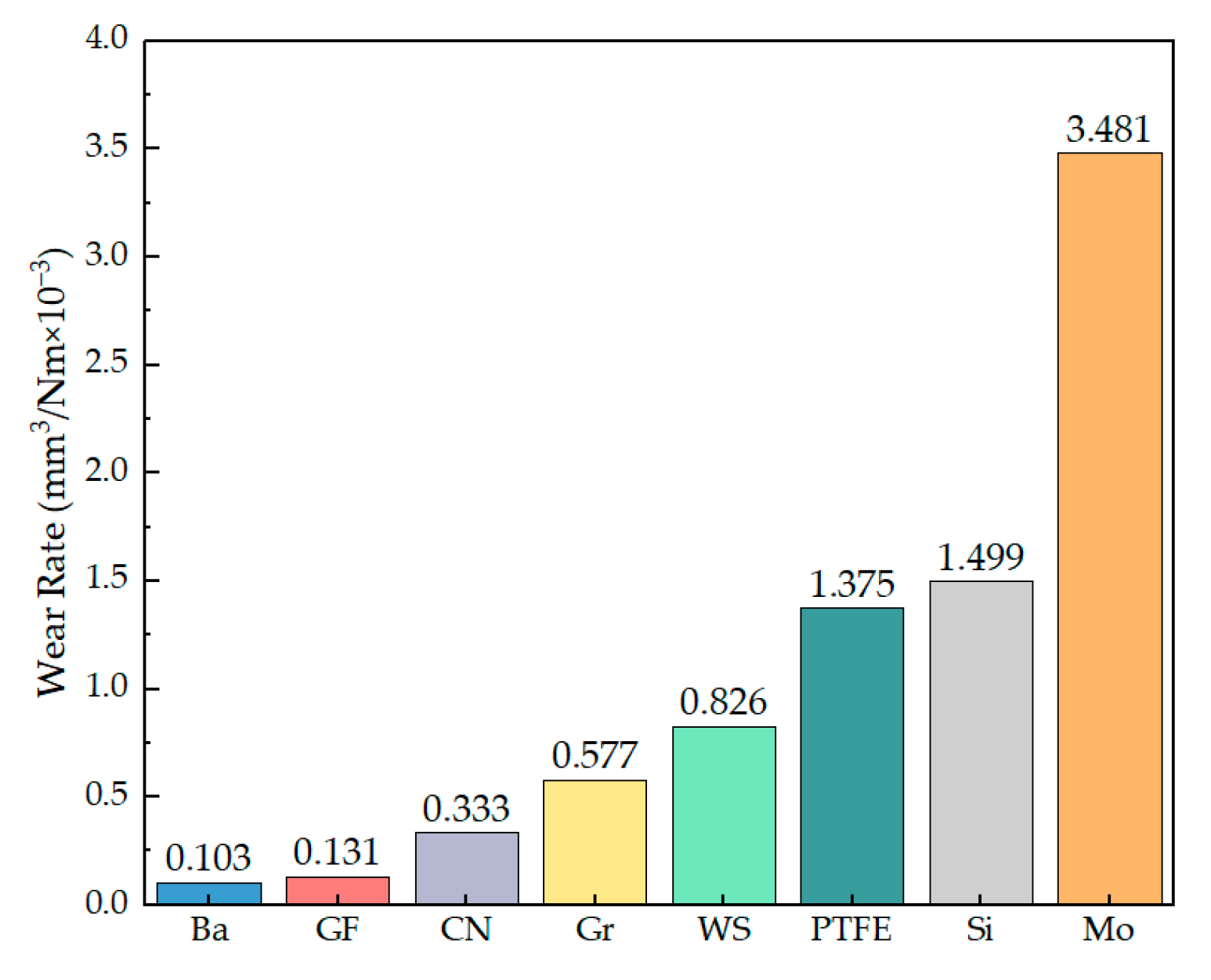

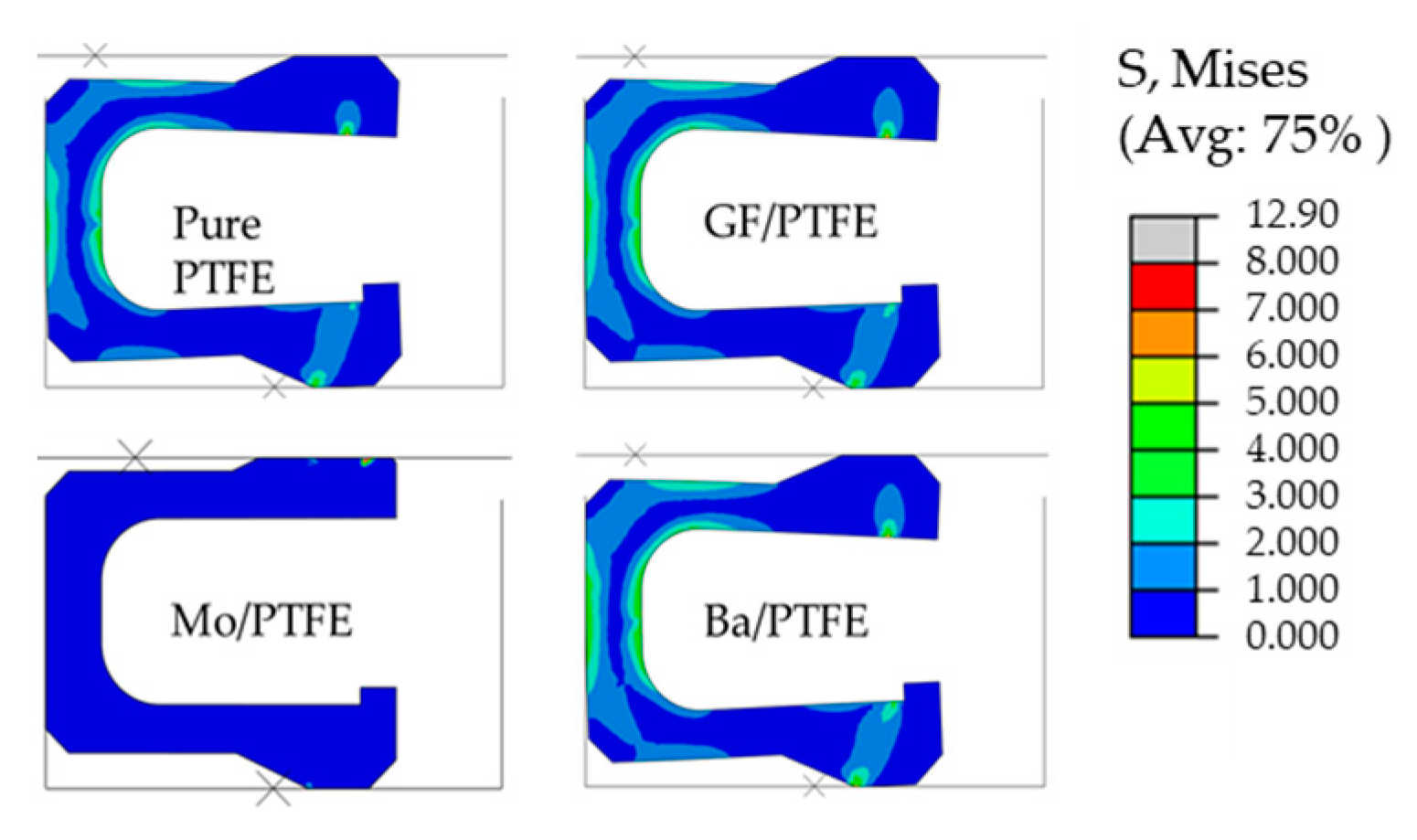
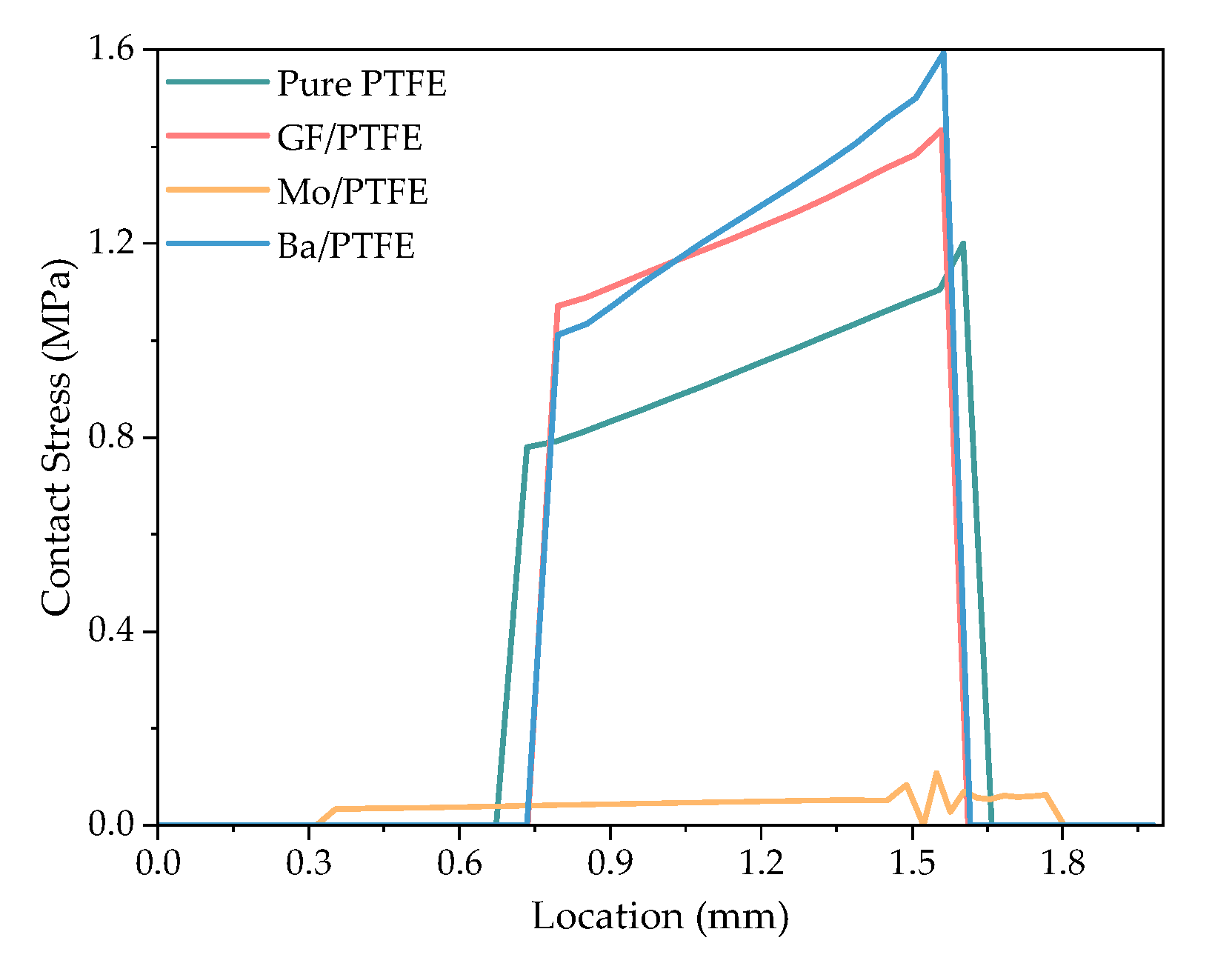

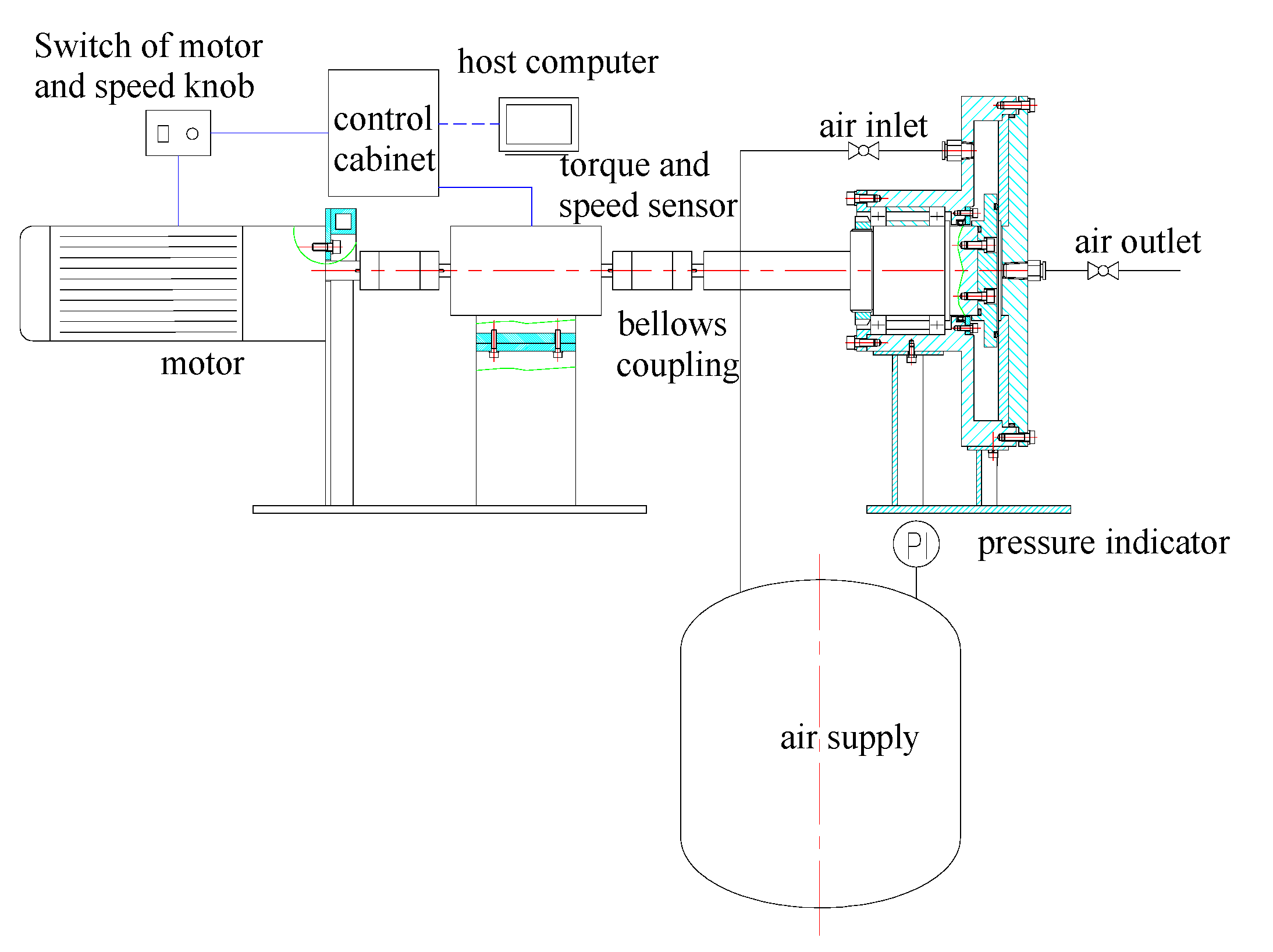

| Elastic Modulus/MPa | Yield Strength/MPa | Poisson Ratio | Tangent Modulus/MPa | Tensile Strength/MPa |
|---|---|---|---|---|
| 193,500 | 1500 | 0.3 | 530 | 1567 |
| Sample | Filler | Size of Filler | Content of Fillers |
|---|---|---|---|
| PTFE | none | - | - |
| Ba/PTFE | BaSO4 | 45 μm | 5 wt.% |
| GF/PTFE | glass fiber | diameter of 13 μm, length of 30 μm | 5 wt.% |
| Si/PTFE | Si3N4 | 1–3 μm | 5 wt.% |
| Mo/PTFE | MoS2 | 30–50 μm | 5 wt.% |
| Gr/PTFE | graphite | 40–60 μm | 5 wt.% |
| WS/PTFE | WS2 | 0.85–1.15 μm | 5 wt.% |
| CN/PTFE | carbon nanotubes | diameter of 9.5 nm, length of 1.5 μm | 5 wt.% |
Disclaimer/Publisher’s Note: The statements, opinions and data contained in all publications are solely those of the individual author(s) and contributor(s) and not of MDPI and/or the editor(s). MDPI and/or the editor(s) disclaim responsibility for any injury to people or property resulting from any ideas, methods, instructions or products referred to in the content. |
© 2024 by the authors. Licensee MDPI, Basel, Switzerland. This article is an open access article distributed under the terms and conditions of the Creative Commons Attribution (CC BY) license (https://creativecommons.org/licenses/by/4.0/).
Share and Cite
Zhao, X.; Li, S.; Liu, D.; Huang, L. Material Optimization Method for a Spring-Energized Seal Based on Wear Analysis. Lubricants 2024, 12, 288. https://doi.org/10.3390/lubricants12080288
Zhao X, Li S, Liu D, Huang L. Material Optimization Method for a Spring-Energized Seal Based on Wear Analysis. Lubricants. 2024; 12(8):288. https://doi.org/10.3390/lubricants12080288
Chicago/Turabian StyleZhao, Xinni, Shuangxi Li, Dengyu Liu, and Lele Huang. 2024. "Material Optimization Method for a Spring-Energized Seal Based on Wear Analysis" Lubricants 12, no. 8: 288. https://doi.org/10.3390/lubricants12080288
APA StyleZhao, X., Li, S., Liu, D., & Huang, L. (2024). Material Optimization Method for a Spring-Energized Seal Based on Wear Analysis. Lubricants, 12(8), 288. https://doi.org/10.3390/lubricants12080288





